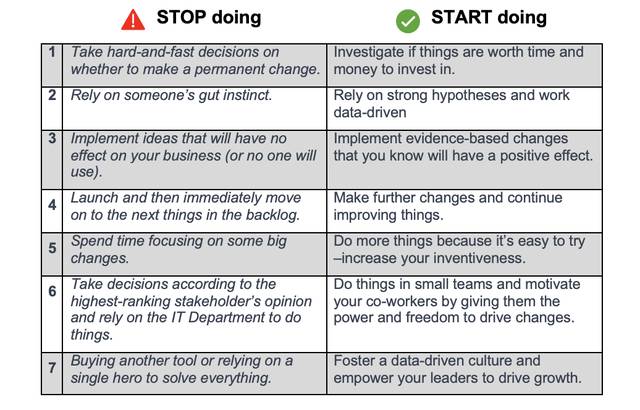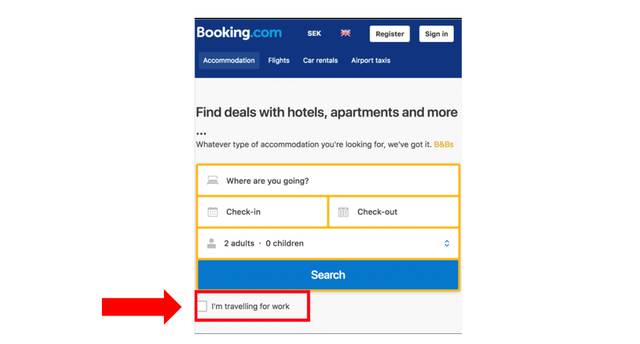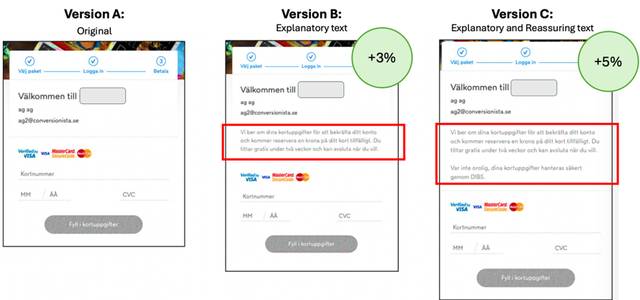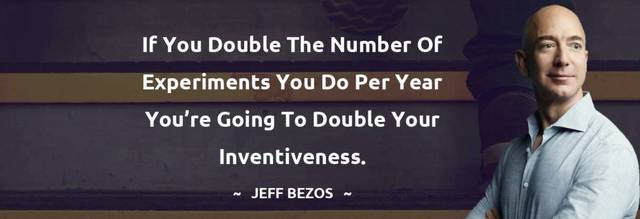
In today's fast-paced digital environment, companies are constantly seeking strategies that deliver measurable results, maximize ROI, and mitigate risks.
This requires a strong emphasis on data-driven decision-making, ensuring that investments in new features, products, or services are worthwhile. Effective resource allocation and continuous improvement are crucial, as organizations need to iterate and refine initiatives based on feedback and data.
Fostering a culture of innovation and experimentation can lead to groundbreaking ideas, and agile team dynamics empower small, autonomous teams to act swiftly.

Stop doing: Take hard-and-fast decisions on whether to make a permanent change.
Before making a firm decision to invest time and money in developing a new feature, product, or service, you should investigate as early as possible whether it is the right path to take. Since people often say one thing but do another, simply asking consumers questions regarding how they think they would behave, is rarely sufficient. What you want to do is test your idea "in the real world" to see how people behave and what choices they make. This should be done with minimal investment (minimum viable experimentation) and as early as possible, before any significant investments are made. Then, you can decide whether the idea is a Go or No-Go.
Example: Minimum Viable Experiment by Booking.com

Booking.com hypothesized that business travelers could benefit from a differentiated user journey. However, before starting the design process, they wanted to test their hypothesis during the idea phase. They conducted a “painted door” test, which involved running an A/B test by adding a checkbox to see if users would select it. In this test, selecting the checkbox did not result in any changes for the visitor. They then analyzed the results to determine if the checkbox negatively impacted conversions and counted how many users selected it, building a business case based on these findings.
Stop doing: Rely on someone´s gut instict.
Working with strong hypotheses means conducting research, analyzing data, summarizing input from customer service, studying behaviors, taking input from previous experiments etc. The more data sources you have, the stronger your improvement hypotheses will be, and the more accurate you will be in your optimization efforts.
The challenge often lies in translating data into actionable insights and incorporating that knowledge into ongoing operations. It is only when you succeed in this that you can proudly claim to be data-driven.
Example: Building an insights team at Polestar
Stop doing: Implement ideas that will have no effect on your business (or no one will use).
The whole idea of A/B testing is to test different variations to see which one performs better. This is done in a live environment against a selected segment. When we A/B test, we have an average win rate of 30%, meaning 70% of our improvement hypotheses have no effect or a negative effect. This indicates that we are generally poor at guessing what will work, even when we build our hypotheses on thorough research. If you translate this to companies that do not A/B test at all, it is likely that 70% of what they implement has no effect or, worse, has a negative impact on the desired outcome. It is probably even worse if decisions are based on guesses and gut feelings.
If you have the prerequisite, you will want to scale up your experimentation program and make it an integral part of everyday operations. In such an environment, data trumps opinion, experiments are conducted ethically, teams are motivated and work autonomously, and the results are positive.
Stop doing: Launch and then immediately move on to next things in the backlog.
If you get a positive result from your A/B test, it means you have struck gold. That is, you have identified an area where visitors make a decision, and you have been able to influence that decision. When you find a gold vein, you should continue digging. You can keep iterating on your variations and make further improvements.
This also indicate that you need to continuously reprioritize your backlog to ensure you invest your resources in what provides the most bang for your buck.
Example: Cmore didn’t settled for a win, they kept digging for better results.
Cmore noticed a significant drop-off at the “enter card details” step during checkout. The analysis revealed that customers had concerns about payment. In an AB-test, they added explanatory text about why card details were required, despite the free trial. This resulted in a 3% increase in conversions. Realizing they could reassure worried visitors and convince them to sign up, they decided to be even more explicit and conducted a second test, an A/B/C test, which yielded even better results.

Stop doing: Spend time focusing on some big changes.
Experiments are key to innovation because they rarely turn out as you expect and you learn so much. If you can increase the number of experiments you will dramatically increase the number of innovations you produce.
As mentioned above, you should aim for minimum viable experiments. By doing so, you will not only reduce costs and time but also increase the opportunity to do more, learn more and innovate more.

Stop doing: Take decisions according to the highest-ranking stakeholder’s opinion and rely on the IT Department to do things.
Companies and organizations are increasingly abandoning waterfall methods in favor of agile working methods. This has more or less become a requirement as the time from an idea to a finished service or product must be short. An effective way to work is in smaller autonomous agile teams with the right resources embedded to help them own and run their services end-to-end. Working in smaller, independent teams not only increases efficiency but also motivation.
The challenge with autonomous teams is that there is a risk of siloed work. Therefore it’s crucial to have the right governance structure in place and also open up to share learnings.
Example: Amazon’s “two-pizza teams” are known for empowering ownership and innovation. The concept is straightforward: no team should be big enough that it would take more than two pizzas to feed them. Smaller teams allow them to spend more time focusing on their customers and constantly experimenting and innovating on their behalf.
Stop doing: Buying another tool or relying on a single hero to solve everything.
As companies strive to foster a data-driven culture and scale up their online experimentation capacity, they often find that the obstacles ar not tools and technology. The obstacles often lie in leadership, culture and methodologies. If you want to address these challenges, we recommend the following approach:
Need help in fostering a data-driven culture and empower your leaders to drive growth? Read more about our services or contact us.
Ready to accelerate your digital growth? Add your details here or email us at hej[a]conversionista.se and we’ll get back to you.
